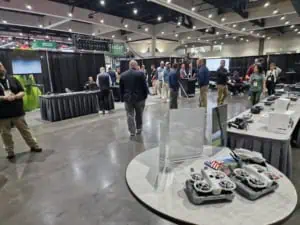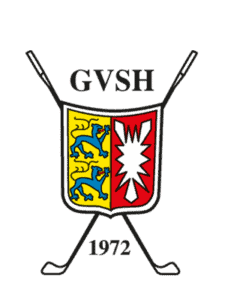Sustainability is increasingly in focus in greenkeeping. This became clear in February at the GCSAA Conference and Trade Show in San Diego, for which new record figures have now been published. With 11,000 visitors, the trade fair, which is the largest of its kind, attracted the highest number of visitors since 2008, whereby it was noticeable that top international facilities, whether from the United Arab Emirates, Asia or Europe, were also represented.
Joel Nunes, President of FEGGA and also Superintendent of the Portuguese high-end facility Monte Rei, gave an extremely positive summary of the trade fair. “Compared to previous years. It felt more vibrant and forward-thinking, with a stronger focus on cutting-edge technology and sustainability, both of which are becoming increasingly vital to the future of our industry.”
Subscribe to our newsletter!
News & trends about sustainability in golf
This was particularly evident in four areas: Drones and data collection, autonomous mowing, irrigation and pesticides. “Drones with an RGB camera are perfectly okay for the normal needs of a golf course,” was the assessment of scientists Elisabeth Kitchin and David McCall, who are working on the sensible collection of data in greenkeeping at the University of Virginia Tech. As part of one of the numerous seminar programs with a total of 6700 participants, they also made it clear that the often significantly more expensive data collection with satellite technology or multispectral cameras is generally not necessary.
Data collection itself is essential and has become an integral part of greenkeeping. “Without data, I’m just another person out there with an opinion,” explained Chris Hartwiger. Director of Agronomy at the United States Golf Association . A greenkeeper’s wealth of experience and his feel for his own golf course are extremely important and indispensable. Ultimately, however, a good argument to management is only possible “if you turn opinion into fact.” To achieve this, the USGA presented a whole set of data collection tools at the trade fair.
Perfecting water treatment
The topic of irrigation, as was also made clear at the trade fair, is becoming an issue for ever larger areas of the global golf market that is also decisive for economic survival. In view of constantly rising water prices, not only in the USA, and increasing criticism of excessive water consumption, especially in the southern states of Europe, it has long been a question of using water as a resource with great care and precision.
In San Diego, for example, Swiss manufacturer Aqua4D demonstrated that the future of irrigation does not lie solely in sophisticated pump systems, sprinklers and precisely planned pipe systems. Rather, it is about the innovative treatment of water, which is broken down into different components so that it can be better absorbed by the grass plant with the optimum addition of nutrients. As a result, less water is ultimately required to maintain or improve quality. Filter systems are particularly relevant when the quality of the water – as is often the case with gray water – is not the best.
‘There is a much stronger focus on solutions for water conservation”, said FEGGA President Nunes. ‘For me, this will be the big thing in the next few years.”
Autonomous mowing on the rise
There was a great deal of curiosity in the mowing sector prior to the trade fair, but this was only partially satisfied by the market leaders with major innovations. A total of seven exhibitors presented themselves at the trade fair, with the Swedish manufacturer Husqvarna in particular flying the flag alongside Toro, John Deere and Jacobsen, providing demonstrations and explanations over two days as part of the training program. “We are still a niche product here,” summarized Sebastian Spörl, Manager Golf & Sports at the Husqvarna Group, “but we are now also seeing increasing interest on the American market. With the Automower 535 AWD Epos and the Automower 580 L, the Swedes offer a solution for very hilly areas and steep slopes (535AWD) as well as a product for higher efficiency and larger areas with a cutting height of up to 10 mm (580L).
Toro presented two new models in this segment of small autonomous mowers, the Range Pro for collecting on the driving range and the Turf Pro, with which it is now operating in the same segment as Kress and Husqvarna.
Chemical use is reviewed
The manufacturers of pestizides could not be overlooked at the trade fair in San Diego. The large presence of Syngenta, EVU and many smaller brands made it clear how strongly the industry is represented in North America and how diverse the application possibilities of pestizides are in the local market compared to Europe, for example.
But Nunes sees changes here too: “‘One noticeable change is the increasing emphasis on reduced environmental impact, and efficient turf management. Even with pesticides, they are searching for more environmentally friendly active ingredients. The industry is clearly moving towards more responsible and sustainable approaches, which is exciting to see.”
Further training secures the future
The topic of sustainability was given a lot of space during the two conference days, which were dedicated exclusively to the area of training and used by numerous trade fair visitors. The increasingly strong connection with science played an important role here. “It is important to separate the marketing view from the data analysis,” emphasized Daniel O’Brien, Green Section Research Manager at the USGA. In greenkeeping, one must always be aware of the fact that manufacturers’ sales claims cannot always be substantiated by studies. Large differences in the performance of wetting agents, for example, are often not verifiable. In addition, according to O’Brien, the data situation in some product fields is relatively poor. “Most of the data comes from the manufacturers themselves,” he noted critically. “So you get to see what the manufacturers want you to see.”
According to the unanimous opinion of the USGA representatives, the head greenkeeper of the future will therefore be able to differentiate between necessary and unnecessary data, classify it correctly and then implement the right measures on the course in order to ultimately guarantee one thing: high quality combined with economical and sustainable management.








 Image: Canva/Petra Himmel
Image: Canva/Petra Himmel